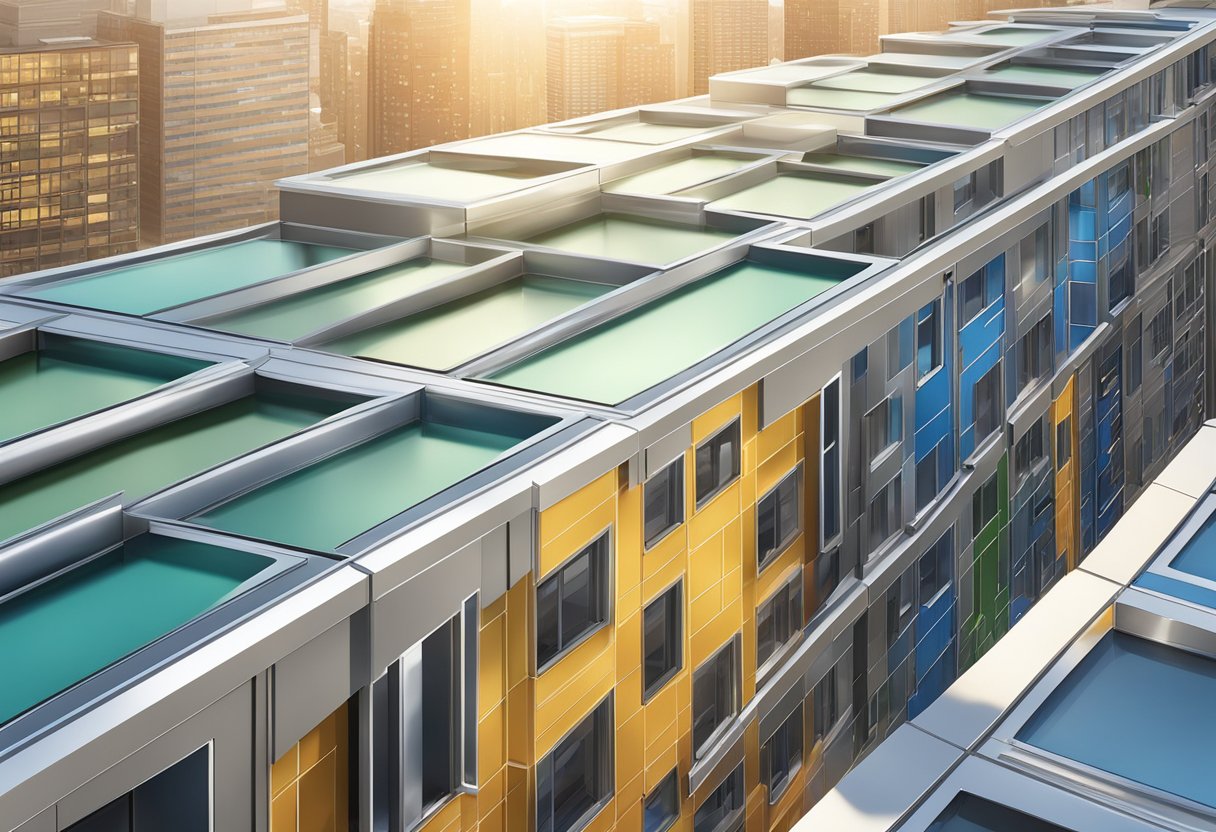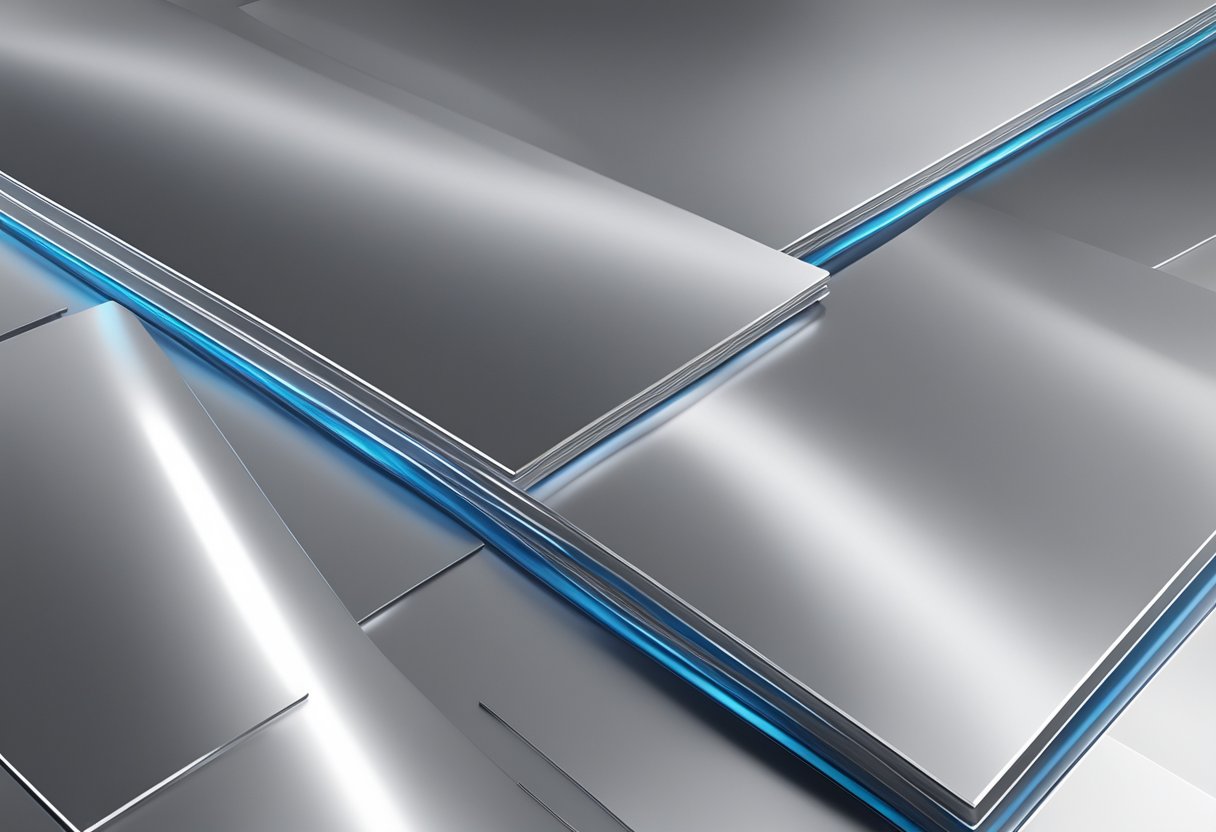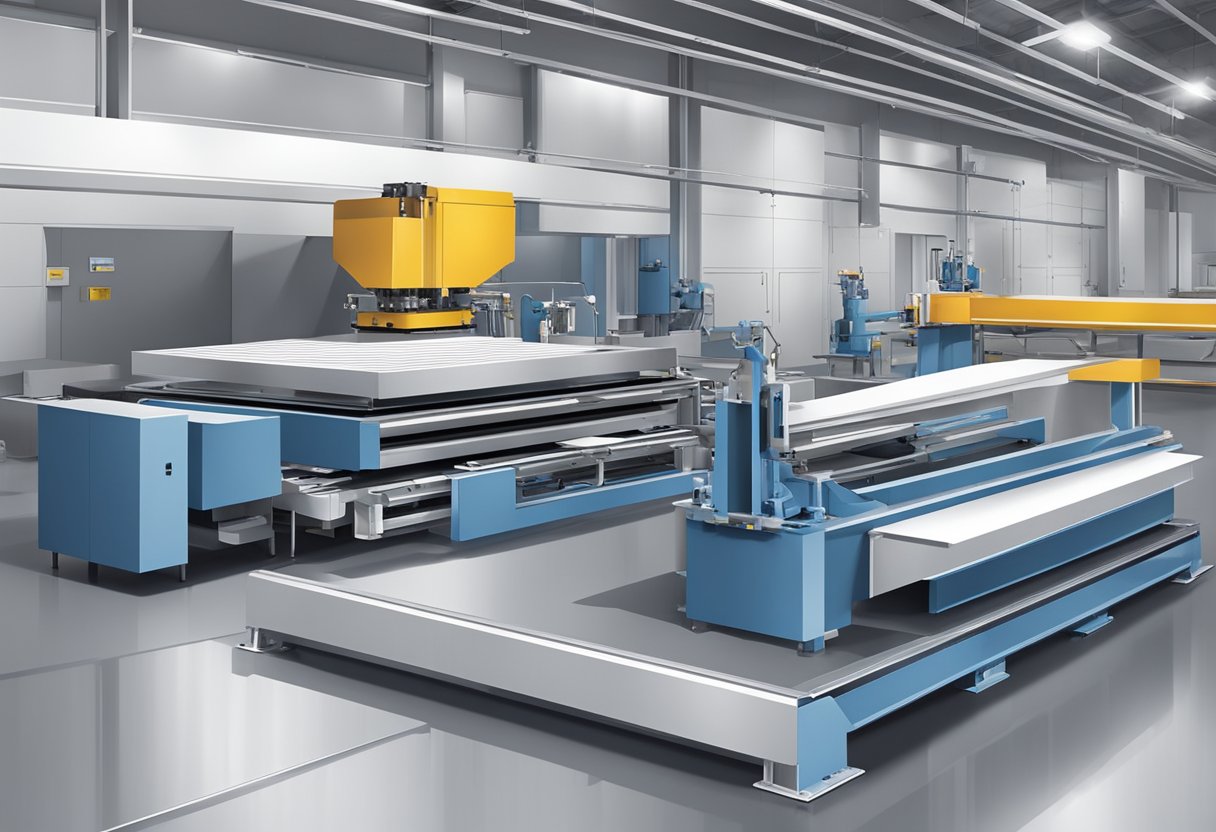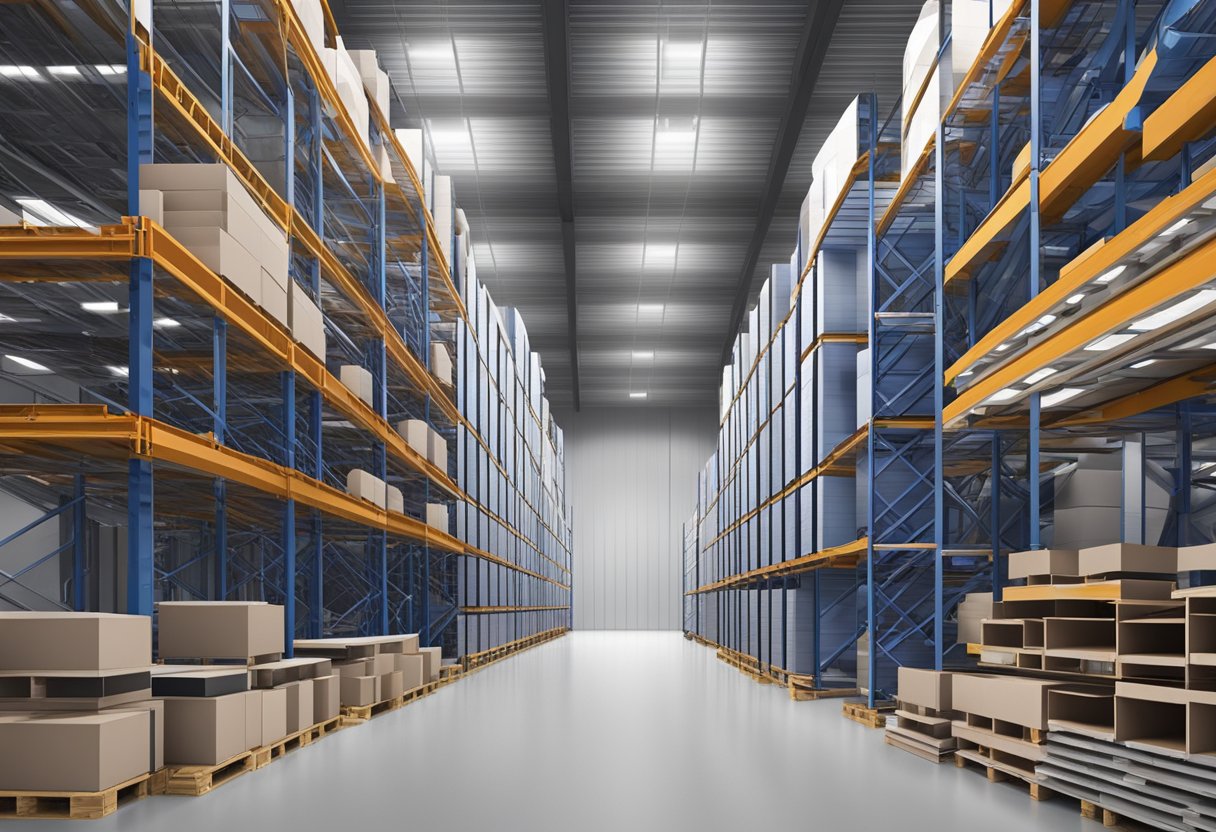Aluminum Composite Material (ACM) panel is a popular building material used in modern construction. It is a sandwich panel made up of two aluminum sheets bonded to a non-aluminum core, usually made of polyethylene, fire-retardant mineral core, or a combination of both. The thickness of the panel varies from 3mm to 6mm, making it a lightweight and versatile material.

ACM panels offer a range of benefits, including durability, flexibility, and cost-effectiveness. They are easy to install and maintain, making them a popular choice for architects and builders. The panels come in a variety of colors, finishes, and textures, allowing designers to create unique and innovative building facades. Additionally, ACM panels provide excellent thermal insulation and soundproofing, making them ideal for energy-efficient buildings.
Composition and Properties

Core Materials
Aluminum composite material (ACM) panels have a three-layered structure consisting of two aluminum sheets bonded to a thermoplastic core material. The core material is typically made of low-density polyethylene (LDPE) or fire-retardant (FR) mineral-filled core. LDPE core is lightweight and flexible, while FR core has better fire resistance properties. The thickness of the core material varies depending on the application and performance requirements.
Surface Coatings
The surface coatings of ACM panels are critical to their performance and aesthetics. The coatings are typically made of either polyvinylidene fluoride (PVDF) or polyester (PE) resin. PVDF coatings are more durable and resistant to weathering, fading, and staining, making them suitable for exterior applications. PE coatings are less expensive but have lower durability and are more prone to fading and staining.
ACM panels come in a variety of colors, finishes, and textures, allowing architects and designers to create visually appealing facades and interiors. The panels can be easily fabricated and installed, making them a popular choice for cladding, signage, and interior decoration applications.
Overall, ACM panels offer a lightweight, durable, and versatile solution for architectural and construction projects. However, it is important to ensure that the panels meet the relevant safety and performance standards and codes to ensure their safe and effective use.
Manufacturing Process

Material Preparation
The first step in the manufacturing process of aluminum composite material panel (ACM) involves preparing the materials. The aluminum sheets are cleaned and treated with a chromate solution to improve adhesion. The core material, which is usually made of polyethylene, is also cleaned and treated with a flame retardant.
Bonding Techniques
Once the materials are prepared, the bonding process begins. There are two main bonding techniques used in the manufacturing of ACM panels: continuous and discontinuous bonding.
In continuous bonding, the core material is continuously fed between two aluminum sheets, which are then bonded together using a high-pressure roller. This results in a continuous panel with a uniform thickness.
In discontinuous bonding, the core material is glued to the aluminum sheets in a patterned or random manner. This results in a panel with varying thicknesses and a more irregular appearance.
Cutting and Shaping
After the bonding process is complete, the panels are cut and shaped to the required size and shape. This can be done using a variety of techniques, including sawing, routing, and punching.
ACM panels can be cut and shaped into a wide range of shapes and sizes, making them a versatile material for a variety of applications. The panels can also be coated with a variety of finishes, including paint, powder coating, and anodizing, to further enhance their appearance and durability.
Types and Varieties

Standard ACM Panels
Standard ACM (Aluminum Composite Material) Panels are widely used for architectural cladding, signage, and interior design applications. They consist of a polyethylene core sandwiched between two aluminum sheets. The aluminum sheets are coated with a high-quality PVDF (Polyvinylidene Fluoride) resin that provides excellent weather resistance and durability. Standard ACM panels are available in a wide range of colors, finishes, and sizes, making them a versatile choice for many applications.
Fire-Retardant ACM Panels
Fire-retardant ACM panels are designed to meet the fire safety requirements of building codes and regulations. They are made with a fire-retardant core that meets the NFPA (National Fire Protection Association) 285 test standard. This test evaluates the fire propagation characteristics of exterior wall assemblies that incorporate combustible components, such as ACM panels. Fire-retardant ACM panels are available in various thicknesses and sizes, and they can be coated with a variety of finishes.
Environmentally Friendly ACM Panels
Environmentally friendly ACM panels are designed to minimize the environmental impact of building materials. They are made with a core material that contains recycled content, such as post-consumer recycled polyethylene or fire-retardant treated (FRT) wood. The aluminum sheets used in these panels are also often made with recycled content. Environmentally friendly ACM panels are available in various colors and finishes, and they can be used for a wide range of applications.
Overall, there are many types and varieties of ACM panels available on the market today. Choosing the right type of ACM panel depends on various factors, such as the application, building codes and regulations, and environmental considerations. It is important to consult with a knowledgeable professional to determine the best ACM panel for your specific needs.
Applications
Architectural Cladding
Aluminum composite material panels are widely used in architectural cladding due to their lightweight, durability, and versatility. They are commonly used as exterior walls, canopies, and facades for buildings. The panels are available in a wide range of colors, finishes, and textures, which makes them suitable for various architectural styles. They can also be easily cut and shaped, allowing architects and designers to create unique and intricate designs.
Signage and Displays
Aluminum composite material panels are commonly used for signage and displays due to their durability, weather resistance, and ease of fabrication. They can be easily cut, routed, and bent to create custom shapes and sizes. The panels are also available in a wide range of colors and finishes, which makes them suitable for branding and advertising purposes. They are commonly used for outdoor signs, billboards, and indoor displays.
Transportation Industry
Aluminum composite material panels are increasingly being used in the transportation industry due to their lightweight and high strength-to-weight ratio. They are commonly used for the construction of trailers, truck bodies, and RVs. The panels are also corrosion-resistant, which makes them suitable for use in harsh environments. Additionally, the panels can be easily cut and shaped, which allows for efficient production and customization of the vehicles.
In conclusion, aluminum composite material panels have a wide range of applications due to their versatility, durability, and ease of fabrication. They are commonly used in architectural cladding, signage and displays, and the transportation industry.
Installation Techniques
Mechanical Fastening
Aluminum composite material panels can be mechanically fastened using a variety of methods. The most common method is through the use of screws, which are typically installed through pre-drilled holes in the panel and into the substrate. Other mechanical fastening methods include rivets and clips. Mechanical fastening is a quick and easy installation method that allows for easy removal and replacement of panels if necessary.
Adhesive Bonding
Adhesive bonding is another installation method for aluminum composite material panels. This method involves applying an adhesive to the back of the panel and then pressing it onto the substrate. Adhesive bonding provides a strong, permanent bond and is ideal for applications where mechanical fastening is not practical or desired. However, it can be a more time-consuming installation method and requires careful surface preparation to ensure proper adhesion.
Panel Joining Methods
When installing aluminum composite material panels, it is often necessary to join two or more panels together. Panel joining methods include tongue and groove, shiplap, and butt joint. Tongue and groove and shiplap joints provide a more secure and weather-resistant joint, while butt joints are simpler and easier to install. It is important to follow the manufacturer’s recommendations for panel joining methods to ensure a proper and secure installation.
Overall, the installation of aluminum composite material panels requires careful planning and attention to detail. By selecting the appropriate installation method and following the manufacturer’s recommendations, a secure and long-lasting installation can be achieved.
Performance Characteristics
Durability
Aluminum composite material panels are known for their excellent durability. They are resistant to weathering, corrosion, and impact, making them an ideal choice for a wide range of applications. The panels are made of two aluminum sheets bonded to a non-aluminum core, which provides additional strength and stability. The core is typically made of polyethylene, a material that is resistant to water, chemicals, and UV radiation.
Thermal Performance
Aluminum composite material panels have good thermal performance. They have a low thermal conductivity, which means that they do not conduct heat well. This makes them an excellent choice for use in buildings where thermal insulation is important. The panels can help to reduce energy consumption and lower heating and cooling costs.
Acoustic Properties
Aluminum composite material panels have good acoustic properties. They can help to reduce noise levels in buildings and provide a more comfortable environment for occupants. The panels can be used in a variety of applications, including walls, ceilings, and floors, to help absorb sound and reduce echo.
In summary, aluminum composite material panels offer excellent durability, good thermal performance, and good acoustic properties. They are a versatile and cost-effective solution for a wide range of applications, including commercial, industrial, and residential buildings.
Standards and Regulations
Building Codes
Aluminum composite material panel is a widely used material in the construction industry. As such, it is subject to various building codes and regulations that govern its use. These codes are put in place to ensure the safety and structural integrity of buildings.
In the United States, the International Building Code (IBC) is the most widely adopted set of building codes. The IBC outlines the minimum requirements for the use of aluminum composite material panel in building construction. It specifies the required thickness, size, and spacing of panels, as well as the necessary fire-resistance ratings.
Fire Safety Standards
Fire safety is a critical concern in building construction, and aluminum composite material panel is no exception. The National Fire Protection Association (NFPA) has established standards for the use of this material in building construction.
NFPA 285 is a standard test method for evaluating the fire propagation characteristics of exterior non-load-bearing wall assemblies containing combustible components. This test is required for aluminum composite material panel used in certain types of buildings, including high-rise buildings, hospitals, and schools.
Environmental Compliance
Aluminum composite material panel is also subject to environmental regulations. The production and disposal of this material can have a significant impact on the environment.
The Environmental Protection Agency (EPA) regulates the disposal of aluminum composite material panel. It is classified as a non-hazardous waste, but it must be disposed of properly to avoid environmental contamination. Additionally, the production of aluminum composite material panel must comply with various environmental regulations, including those related to air emissions and wastewater discharge.
Overall, compliance with building codes, fire safety standards, and environmental regulations is crucial when using aluminum composite material panel in building construction. Proper adherence to these standards ensures the safety and sustainability of buildings.
Maintenance and Care
Cleaning Procedures
Aluminum composite material panels require regular cleaning to maintain their aesthetic appearance and prevent the buildup of dirt and grime. The cleaning frequency depends on the location of the panels and the level of pollution in the area. In general, it is recommended to clean the panels at least twice a year.
To clean the panels, start by rinsing them with water to remove loose dirt. Then, use a soft-bristled brush or a sponge to apply a mild detergent solution and scrub the panels gently. Avoid using abrasive cleaners or steel wool, as they can scratch the surface of the panels. Rinse the panels thoroughly with water and dry them with a soft cloth.
Inspection and Repair
Regular inspection of the aluminum composite material panels is essential to identify any damage or defects. The inspection frequency depends on the location of the panels and the level of exposure to environmental factors such as wind, rain, and sunlight. In general, it is recommended to inspect the panels at least once a year.
During the inspection, check for any signs of cracks, dents, or discoloration. If any damage is detected, it should be repaired promptly to prevent further deterioration. The repair process involves replacing the damaged panel or applying a patch to cover the affected area.
Longevity and Replacement
Aluminum composite material panels are durable and long-lasting, with a lifespan of up to 20 years or more. However, their longevity depends on several factors such as the quality of the material, the installation process, and the maintenance and care practices.
If the panels are properly maintained and cared for, they can last for many years without requiring replacement. However, if the panels are damaged beyond repair or have reached the end of their lifespan, they should be replaced promptly to ensure the safety and integrity of the building. It is recommended to consult a professional contractor for the replacement process to ensure proper installation and adherence to building codes and regulations.



